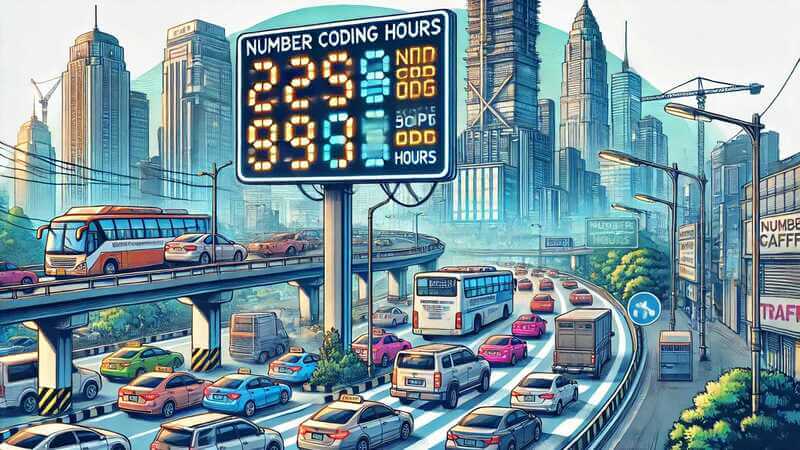Metro Manila, the bustling capital region of the Philippines, is notorious for its traffic congestion. To address this issue, the government implemented a traffic management system known as “number coding” or the Unified Vehicular Volume Reduction Program (UVVRP). Understanding the coding hours in Metro Manila is essential for drivers to avoid fines and optimize their travel schedules. This article will guide you through everything you need to know about coding hours, exemptions, and tips to navigate the city smoothly.
What Are Coding Hours in Metro Manila?
Coding hours refer to the periods during which vehicles with specific plate number endings are prohibited from operating on certain major roads in Metro Manila. The scheme aims to reduce the volume of vehicles on the road and alleviate traffic congestion.
Schedule for Number Coding
The restriction depends on the last digit of your vehicle’s license plate. Here’s the schedule:
| Plate Number Ending | Restricted Days |
|---|---|
| 1 and 2 | Monday |
| 3 and 4 | Tuesday |
| 5 and 6 | Wednesday |
| 7 and 8 | Thursday |
| 9 and 0 | Friday |
Time Restrictions
Coding hours typically apply during the following times:
- Morning: 7:00 AM to 10:00 AM
- Afternoon/Evening: 5:00 PM to 8:00 PM
These hours may vary slightly depending on the city within Metro Manila. For example:
- Makati City enforces coding during both time slots.
- Some cities, like Pasig, suspended the afternoon coding hours.
Exemptions to the Coding Scheme
Several exemptions allow certain vehicles to operate despite the coding restrictions. Here are some common exemptions:
- Public Utility Vehicles (PUVs): Jeepneys, buses, and tricycles are generally exempt.
- Emergency and Government Vehicles: Ambulances, fire trucks, and official government vehicles are not subject to coding.
- Motorcycles: These are also exempt from the coding scheme.
- Senior Citizen and PWD Vehicles: Cars with valid senior citizen or PWD stickers may be exempt.
- Electric Vehicles: As of recent regulations, electric vehicles may also be exempt from coding.
Areas Covered by the Number Coding Scheme
The coding system is enforced in major cities across Metro Manila, including:
- Makati
- Quezon City
- Manila City
- Pasig
- Parañaque
- Mandaluyong
- Caloocan
However, some cities, like Marikina and Taguig, do not implement the coding scheme. It’s important to check the regulations of each city before traveling.
Penalties for Violating the Coding Scheme
Drivers caught violating the coding restrictions are subject to fines. The penalty for non-compliance ranges from PHP 300 to PHP 500, depending on the city. Repeated offenses may lead to higher fines or other consequences.
Tips to Navigate Metro Manila During Coding Hours
To avoid inconvenience and maximize your travel efficiency, here are some tips for navigating Metro Manila:
- Plan Ahead: Schedule your trips outside coding hours. Utilize navigation apps like Waze or Google Maps to find alternative routes and check traffic conditions.
- Use Window Hours: Some cities allow “window hours,” during which coding restrictions are lifted. For instance, Makati’s window hours are usually between 10:00 AM and 3:00 PM.
- Carpooling and Ride-Hailing Services: If your car is coded, consider using ride-hailing apps like Grab or joining a carpool to get around.
- Consider Alternative Transportation: Metro Manila offers various public transportation options, including MRT, LRT, and buses. These can help you bypass coding restrictions.
- Apply for an Exemption: If eligible, secure a coding exemption for your vehicle. This is especially useful for medical practitioners, business owners, or other professionals requiring frequent travel.
Recent Updates to the Coding Scheme
The number coding system may change over time due to evolving traffic conditions or government policies. For example, during the pandemic, the Metro Manila Development Authority (MMDA) temporarily suspended coding but later reintroduced it with adjustments.
To stay updated, monitor announcements from the MMDA through their website or social media channels.
Conclusion
Understanding the coding hours in Metro Manila is crucial for a hassle-free driving experience. By knowing the schedule, being aware of exemptions, and planning your trips strategically, you can navigate the city’s roads efficiently and avoid penalties. Whether you’re a local resident or a visitor, adhering to these rules not only saves you time and money but also contributes to reducing Metro Manila’s traffic woes.
Keep this guide handy for your next trip to Metro Manila, and drive responsibly!
